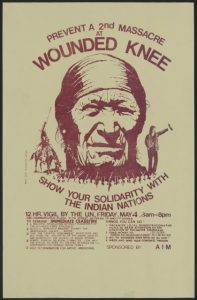Chavers, Dean. “Alcatraz Is Not an Island.”
This source is an interview with Native American activist, Dr. Dean Chavers. Dr. Chavers was one of the first activists to occupy Alcatraz island during the protest. He detailed the events leading up to the occupation as well as the influence of the protest on the success of the movement. In 1969 a group of Native American activists occupied the former prison Alcatraz and demanded rights to the island under the power of the Treaty of Fort Laramie which deemed any surplus land no longer in use by the federal government to be returned to the Lakota tribe. This occupation lasted 18-months until it was ended by the United States government. This was the first of many occupations that would occur in the following years. The intended audience of this source would likely be anyone interested in the history of Native American activism and how the American Indian Movement. This protest would help to embolden many activists especially in the American Indian Movement group which would lead several protests throughout the 1970s.
Maggiora, Vincent, This Land is My Land, 1969, photograph, San Francisco Chronicle

This photograph was taken by Vincent Maggiora in 1969 during the occupation of Alcatraz by Native American activists in 1969. Vincent Maggiora was one of the few members of the media invited to document the protest. According to the San Francisco Chronicle, this along with several other photographs were recently recovered in an archived book of negatives taken by Vincent Maggiora fifty years prior. These images give incite into the feelings of Native Americans during this period and their want to reclaim the lands they lost during the 19th and early 20th century.. This is especially true given the substantial poverty of Native American communities as well as the lack of Native American representation in the United States government. The activists in the photograph are putting up a sign that says, “This Land is My Land”, this reclaiming of what was rightfully theirs was a major purpose of the occupation. More than 300 Native American peoples spent time on Alcatraz while
American Indian Movement (AIM) , “Show your Solidarity with the Indian Nations,” poster from Wounded Knee occupation, 1973,”

The American Indian Movement (AIM) group was one of the first activism groups for Native Americans and was by far the most successful in terms of generating change in the federal government. This poster in particular was made by the AIM and it calls for solidarity with Native American nations following a large conflict on the Pine Ridge Reservation in South Dakota. AIM activists as well as members of the Ogala Lakota tribe occupied a trading post in the Wounded Knee area of the Ogala Lakota reservation. The protest followed a failed attempt to impeach the Tribe chairman Richard Wilson. He was believed by many members of the American Indian movement to be controlled by the Bureau of Indian Affairs. This resulted in a 71 day standoff involving tribal police, AIM, local tribes people, and federal agents. Several Native Americans were killed along with many others injured. This document was likely developed to help create support for Native Americans and specifically the AIM group and their goals. The intended audience was likely Native Americans who were not yet involved in the movement.
Behind the Trail of Broken Treaties An Indian Declaration of Independence by Vine Deloria Jr. The New York Times (1974)
This newspaper article by Dee Brown details the ideas of Vine Deloria as expressed in her book Behind the Trail of Broken Treaties. The source details the role of Deloria in the American Indian movement as well as the events leading up to the Wounded Knee conflict in 1973. Specifically, this article speaks on the need for the United States federal government to return to the process of treaty making. This would require the United State to for the first time in over a hundred years recognize Native American tribes as sovereign entities. The article also goes into detail in terms of the problems associated with treating Native Americans as just another disenfranchised group, he argues that Native peoples never wanted to be enfranchised by the United States to begin with. The most important aspect of this article is the discussion of the Twenty Points, a framework for the restoration of Native American sovereignty and reparations for the treaties broken by the federal government over the past century. These points were the focus of many of the protests that occurred during the 1970s; however, the Federal government never addressed many of the grievances listed in the framework. The intended audience of this article was the New York Times reader base as well as those interested in the American Indian Movement.

